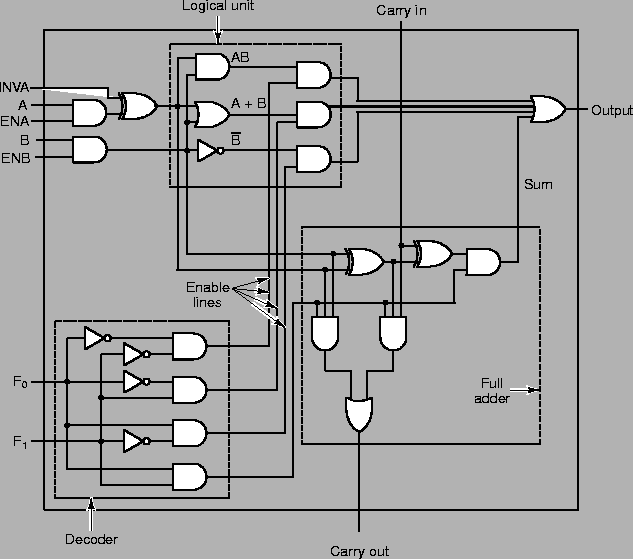- (a)
- Verify the following Boolean relation:

- (i)
- algebraically; if you wish, refer to Appendix 2;
- (ii)
- using a truth-table.
[5marks] - (b)
- Assuming eight-bit twos complement signed representation, perform the
following arithmetic computations in binary. In each case, supplement your
answer with conversions of both operands, and the result, to decimal;
moreover, indicate whether your result is valid or invalid, and, if invalid,
give a clear indication why.
(i) (ii) (iii) 1000 0110 1000 0111 1000 1111 +0000 0101 +1111 1110 +1000 0000 --------- --------- ---------[6marks] - (c)
- Figure A.1
shows a one bit ALU.
- (i)
- Explain the purpose of F0, F1.
[2marks]
- (ii)
- Paying attention to the decoder section, describe precisely
the outputs on each enable line (refer to them as
E0, E1, E2,
E3, reading from the top), for each possible input of
F0, F1.
[4marks]
- (iii)
- Show how eight of one-bit ALUs may be combined to produce an eight bit
ALU.
[3marks]
[B2.] Assembly Language Programming and the Assembly Process
- (a)
- The following example shows an implementation of an IF ...THEN ...ELSE
construct in Mac-1 assembly language.
L0: LODD a0 SUBD a1 JPOS L2 JZER L2 L1: LOCO 1 STOD a2 JUMP L3 L2: LOCO 0 STOD a2 L3: ...- (i)
- Determine the contents of the IF condition, and the THEN and ELSE
parts of the program and describe it using Java or suitable pseudo-code.
[2marks]
- (ii)
- Add comments to each line of the assembly code, to explain how the assembly language performs the task, and replace the labels L0, L1, L2, L3 with more explanatory labels (e.g. IF, THEN, ELSE, ...).
[4marks] - (b)
- Referring to Appendix 1.1, manually assemble the Mac-1 assembly code
given in (a); give brief explanations of any significant steps. Assemble the
program to start at location 100Hex; you may assume that the variables
a0, a1, ..., a10will be at addresses 500Hex, 501Hex, ...50AHex.[10marks] - (c)
- Explain, with the aid of examples, the memory addressing modes:
immediate, direct, and indirect.
[4marks]
[B3.] Input-Output, and Subprogam Handling
- (a)
- The following describes a simple memory mapped input-output scheme used
by Mac-1:
Mac-1a uses memory-mapped input-output, wherby some memory cells are mapped to input-output ports; for simplicity we assume that there are only two ports, one connected to a standard-input device, another connected to a standard-output device.
Input: data port is mapped to 4092/FFCHex (lower-order byte = data byte); status port is mapped to 4093/FFDHex, when the sign bit (most significant bit) is set, this denotes data available.
Output: data port is mapped to 4094/FFEHex (lower-order byte); status 4095/FFFHex; sign bit set denotes ready ...
Briefly, explain the principle used in both read and write operations.
[3marks] - (b)
- Write a program fragment which will, paying proper attention to
ready status, write the contents of the lower- order byte of
address 500 to the output device mentioned in part (a).
[4marks]
- (c)
- Referring to Appendix 1.2, explain the operation of the Mac-1
instructions:
callandretn; you should mention the roles of the stack and stack pointer; illustrate your answer with appropriate examples / diagrams. In your answer please mention the major reasons whycallandretncannot be replaced by simplejumpinstructions.[7marks] - (d)
- Write a Mac-1 subprogram to find the maximum of two integers, i.e. in
Java-like syntax:
int max(int x, int y) { if (x > y) return x; else return y; }and the call:
c = max(a, b);Pay particular attention to: (i) in the calling program, how to pass the two arguments via the stack, and how to call the subprogram; (ii) in subprogram
maxitself, how to access the two parametersx, y. Hint:lodl, andsubl- for the comparison.[6marks]
